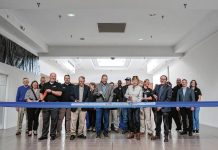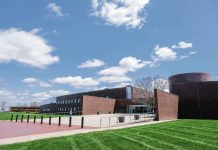When the Purdue Polytechnic Institute in Columbus opens its doors for the new school year, classes will be flipped upside down.
At least that will be the case in Austin Creasy’s classroom, where he will teach mechanical engineering technology following an inverted-classroom model.
That begins Monday with the start of classes for the fall semester.
Creasy’s approach to teaching is designed to align with a new philosophy of learning at the Polytechnic Institute, where professors allow students to take control of their own education.
[sc:text-divider text-divider-title=”Story continues below gallery” ]
“The class becomes less of an instructor-centered one and more of a student-centered class,” said Joe Fuehne, director of the Purdue Polytechnic Institute Columbus campus.
“Students can work at their own pace and accomplish the competencies on their own timeline and finish the material in their own way.”
In May, the Purdue College of Technology officially changed its name to the Purdue Polytechnic Institute as a reflection of the school’s dedication to new learning practices in a new era, Fuehne said.
Today’s science, technology, engineering and math (STEM) learners retain little information provided through a traditional teaching model, which usually involves a professor lecturing from the front of a classroom, Fuehne said.
“With lectures, we know that people are usually tuned out 10 or 15 minutes after we start,” Fuehne said. “The amount of recollection is pretty small.”
Instead, students need to feel a sense of responsibility and ownership of their education, which is why the Polytechnic Institute is shifting its focus toward more student-led classes.
“The goal was to point us toward a more integrated, hands-on, learn-by-doing education,” Fuehne said. “We’ve always had a learn-by-doing education model, but this is more than we’d ever had before.”
In Creasy’s classroom, hands-on learning means flipping the traditional lecture and homework model of learning on its head. Instead of taking notes in class and attempting to work through real-life applications of the material at home, his students read and learn at home then come to class and work through the material together.
“That way, when misconceptions show up, or difficulties, they’re not at home trying to do Google searches or calling a friend who’s just as lost of them,” Creasy said. “I get more one-on-one time with them.”
Tests, grades still a part
Creasy said he has always advocated hands-on learning, so the new Polytechnic Institute learning model mixes well with his preferred personal teaching style.But there’s more to student-led learning than simply flipping the classroom, he said, which is why he and the entire school are exploring a new competency-based grading system.“Instead of having due dates for assignments, there’s material provided for them, and we still use the flipped approach,” Creasy said. “There’s homework still associated, but students work at their own pace to get the homework done.”
Creasy piloted his own version of the competency-based learning model this summer when he taught a group of home-schooled students. There were no strict deadlines, which meant students could complete assignments when they felt comfortable with the material.
Creasy’s college classes this fall will include parts of the competency-based learning system, although he said he doesn’t know exactly how yet.
But even with the relaxed deadline system, his students will still take tests and receive grades.
“Some employers still rely on GPA, so it’s not something we can totally eliminate,” Fuehne said. “But when it makes sense for us to get away from grades, I think we will.”
Purdue Polytechnic Columbus students say they appreciate the school’s dedication to practical applications of learning, both now and in the past.
“There’s always been a hands-on learning style, which is good for me, because that’s how I learn,” said Caleb Faulkner, a second-year Purdue Polytechnic student in the mechanical engineering technology program. “Being able to hear the theories then actually practice them, it’s nice.”
Attention to humanities
In addition to the increased emphasis on student-led, interactive learning, Fuehne said the Polytechnic Institute is trying to incorporate the humanities into its science-based courses.Even though many of the school’s students want to work in laboratories or factories, basic communication skills are essential to their careers, Fuehne said.“There’s no getting away from (writing),” he said. “They’re gonna do interim reports, weekly reports, final reports and presentations along the way.”
To show students how the two worlds can come together, Fuehne said, faculty members are looking for ways to combine technical classes with the school’s few humanities courses.
This fall, for example, Fuehne said, the institute will begin combining the mechanical engineering technology capstone class with a required technical writing class.
“We want to create a real experience in technical design but at the same time technical communication,” Fuehne said. “Whether it be writing or speaking, we want to blend the technical together with more of the literature, arts and humanities sort of approach.”
While all eight Purdue Polytechnic Institute campuses are adopting the student-led approach to learning, Fuehne said hands-on STEM training is particularly important in Columbus because of the dominant presence of the manufacturing industry.
“When you look at the manufacturing business, people don’t necessarily sit at their desks all day and punch into a computer,” he said. “There’s more to the whole manufacturing part that lends itself well to hands-on, learn-by-doing activities, and that’s one reason manufacturers and employers need employees to have that training.”
Students say they’re also aware of the demands of a career in manufacturing, but an education from Purdue Polytechnic makes them feel more prepared to enter the real world.
“I flipped between the (IUPUC) mechanical engineering and (Purdue Polytechnic) mechanical engineering technology programs, but the deciding factor for me was the hands-on learning,” said Tristan Walkins, a sophomore Purdue Polytechnic Columbus student.
[sc:pullout-title pullout-title=”About Purdue Polytechnic” ][sc:pullout-text-begin]
- 4444 Kelly St., Columbus
- 812-348-2025
- Degree options: Bachelor of Science degrees from Purdue University in mechanical engineering technology, organizational leadership, computer and information technology, supply chain management technology (fall 2016), industrial engineering technology (fall 2016), engineering technology with a specialization in robotics (spring 2016)
- Fall 2015 enrollment: Estimated 135 students
[sc:pullout-text-end][sc:pullout-title pullout-title=”About the new teaching model” ][sc:pullout-text-begin]
Purdue Polytechnic Institute changes
- More hands-on learning: Laboratory assignments, student-led learning.
- Competency-based learning: Students finish assignments at their own pace when they feel comfortable with the material.
- Integrating humanities: Combining technical classes with writing, public speaking courses.
[sc:pullout-text-end]




